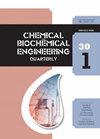Comparison of Conventional and Novel Pre-treatment Methods for Bioethanol Production from Fruit and Vegetable Wastes
IF 0.9
4区 生物学
Q4 BIOTECHNOLOGY & APPLIED MICROBIOLOGY
引用次数: 2
Abstract
In this study, novel and conventional techniques for the production of bioethanol from fruit and vegetable wastes (FVWs) by yeast and bacterial fermentation were investigated experimentally. Different pretreatment techniques (acid, heat, acid/heat, and microwave) for yeast fermentation were compared. Maximum ethanol concentrations of 11.7 and 11.8 g L–1 were observed from acid/heat and microwave pretreatment, respectively, by using Saccharomyces cerevisiae. On the other hand, biochar production from FVWs and syngas fermentation from the waste gas of this process were integrated. From waste gas with 12 % CO content, 5.5 g L–1 and 2.5 g L–1 ethanol production was observed by using anaerobic mixed culture and Clostridium ljungdahlii, respectively. The overall results emphasize the potential of bioethanol production from FVWs by economically feasible and environmentally friendly methods.果蔬废弃物制备生物乙醇的传统与新型预处理方法的比较
本文研究了利用酵母和细菌发酵从果蔬废弃物中生产生物乙醇的新技术和传统技术。比较了酵母发酵的不同预处理技术(酸、热、酸/热和微波)。酸/热预处理和微波预处理的乙醇最高浓度分别为11.7和11.8 g L-1。另一方面,将FVWs生产生物炭与该工艺废气的合成气发酵相结合。以CO含量为12%的废气为原料,分别采用厌氧混合培养和隆达梭菌制备了5.5 g L-1和2.5 g L-1的乙醇。总体结果强调了通过经济可行和环境友好的方法从汽车生产生物乙醇的潜力。
本文章由计算机程序翻译,如有差异,请以英文原文为准。
求助全文
约1分钟内获得全文
求助全文
来源期刊
CiteScore
2.70
自引率
6.70%
发文量
23
审稿时长
>12 weeks
期刊介绍:
The journal provides an international forum for presentation of original papers, reviews and discussions on the latest developments in chemical and biochemical engineering. The scope of the journal is wide and no limitation except relevance to chemical and biochemical engineering is required.
The criteria for the acceptance of papers are originality, quality of work and clarity of style. All papers are subject to reviewing by at least two international experts (blind peer review).
The language of the journal is English. Final versions of the manuscripts are subject to metric (SI units and IUPAC recommendations) and English language reviewing.
Editor and Editorial board make the final decision about acceptance of a manuscript.
Page charges are excluded.

 求助内容:
求助内容: 应助结果提醒方式:
应助结果提醒方式:


